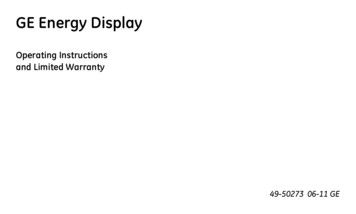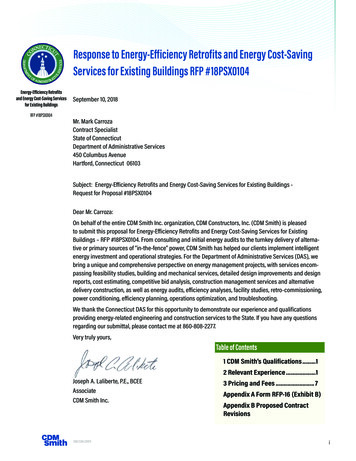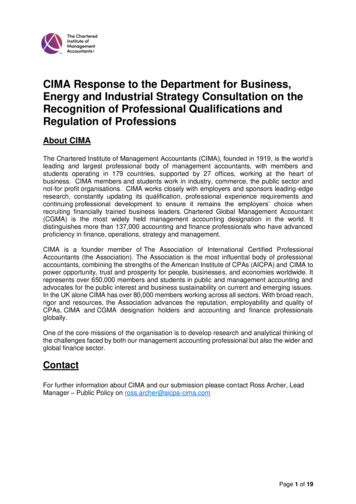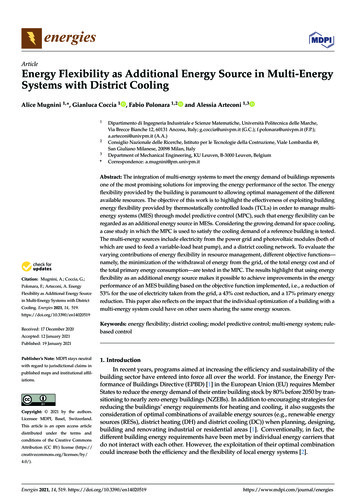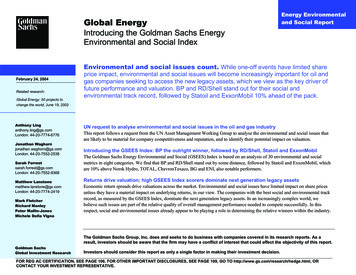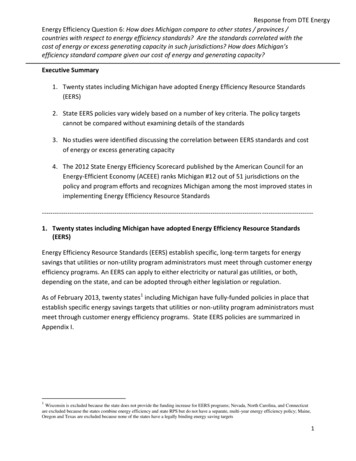
Transcription
Response from DTE EnergyEnergy Efficiency Question 6: How does Michigan compare to other states / provinces /countries with respect to energy efficiency standards? Are the standards correlated with thecost of energy or excess generating capacity in such jurisdictions? How does Michigan’sefficiency standard compare given our cost of energy and generating capacity?Executive Summary1. Twenty states including Michigan have adopted Energy Efficiency Resource Standards(EERS)2. State EERS policies vary widely based on a number of key criteria. The policy targetscannot be compared without examining details of the standards3. No studies were identified discussing the correlation between EERS standards and costof energy or excess generating capacity4. The 2012 State Energy Efficiency Scorecard published by the American Council for anEnergy-Efficient Economy (ACEEE) ranks Michigan #12 out of 51 jurisdictions on thepolicy and program efforts and recognizes Michigan among the most improved states inimplementing Energy Efficiency Resource -----------------------------------1. Twenty states including Michigan have adopted Energy Efficiency Resource Standards(EERS)Energy Efficiency Resource Standards (EERS) establish specific, long-term targets for energysavings that utilities or non-utility program administrators must meet through customer energyefficiency programs. An EERS can apply to either electricity or natural gas utilities, or both,depending on the state, and can be adopted through either legislation or regulation.As of February 2013, twenty states1 including Michigan have fully-funded policies in place thatestablish specific energy savings targets that utilities or non-utility program administrators mustmeet through customer energy efficiency programs. State EERS policies are summarized inAppendix I.1Wisconsin is excluded because the state does not provide the funding increase for EERS programs; Nevada, North Carolina, and Connecticutare excluded because the states combine energy efficiency and state RPS but do not have a separate, multi-year energy efficiency policy; Maine,Oregon and Texas are excluded because none of the states have a legally binding energy saving targets1
Response from DTE EnergyEnergy Efficiency Question 6: How does Michigan compare to other states / provinces /countries with respect to energy efficiency standards? Are the standards correlated with thecost of energy or excess generating capacity in such jurisdictions? How does Michigan’sefficiency standard compare given our cost of energy and generating capacity?Energy Efficiency Resource Standards2. State EERS policies vary widely based on a number of key criteria. The policy targetscannot be compared without examining details of the standardsState EERS policies vary widely based on a number of key criteria:Definition of targeted reduction in electricity use: EERS policies define reductions in one of twodifferent ways: annual or cumulative reductions. An annual reduction specifies the new energysavings required in a given year from investments made in that year (e.g., 1% annual reductionin Michigan) , whereas a cumulative reduction sets the total amount of reductions to beachieved in a given year from all policies implemented up through that year (e.g., 10%cumulative reduction by 2020 in New Mexico).Each of the definitions of energy use reduction can be characterized as either quantity orpercentage reductions. Policies with a quantity reduction specify the requirement in physicalunits (e.g., 7,842 GWh cumulative reduction from 2010-2019 in Florida), whereas policies with apercentage reduction specify the requirement as a percentage of the relevant baseline (e.g., 1%annual reduction in Michigan).The quantity reductions are easy to compare across states. The percentage reductions,however, are not because they are defined relative to baselines that vary across states. Somestates use a fixed baseline (e.g., New Mexico’s 10% cumulative reduction is applied to 2005retail sales), and other states use a rolling baseline (e.g., Michigan’s 1% annual reduction isapplied to prior year’s retail sales)2
Response from DTE EnergyEnergy Efficiency Question 6: How does Michigan compare to other states / provinces /countries with respect to energy efficiency standards? Are the standards correlated with thecost of energy or excess generating capacity in such jurisdictions? How does Michigan’sefficiency standard compare given our cost of energy and generating capacity?Unlike fixed baselines, rolling baselines are affected by the level of compliance in prior years.Rolling baselines also introduce more uncertainty by linking required reductions to exogenouschanges in energy sales resulting from the level of economic activity, weather, demographics,or other factors2. As mentioned earlier, Michigan’s EERS policy uses a rolling baseline: theannual percentage reduction requirement is based on prior year retail sales.Application to natural gas sales: all the EERS states have established reduction targets onelectricity sales. 11 of those EERS states, including Michigan, have established reduction targetson natural gas sales.Application of EERS to Electricity and Natural Gas SalesApplication to both electricityApplication to electricity sales onlyand natural gas ColoradoMarylandIllinoisNew montMinnesotaWashingtonNew YorkRhode IslandPercent of sales covered by policies: state EERSs also vary in terms of which sales are coveredby the policy, and relatedly, which entities are responsible for complying with the policy. Thefollowing table demonstrates the difference in policy coverage and obligated entities in thestate EERS. Policy coverage on retail sales ranges from 57% to 100%. Michigan is one of sevenstates that have 100% of retail sales covered by EERS policies.2K. Palmer, S. Grausz, B. Beasley and T. Brennan. Putting a Floor on Energy Savings: Comparing State Energy Efficiency Resource Standards.Feb 2012. http://www.rff.org/RFF/Documents/RFF-DP-12-11.pdf. Accessed March 19, 20133
Response from DTE EnergyEnergy Efficiency Question 6: How does Michigan compare to other states / provinces /countries with respect to energy efficiency standards? Are the standards correlated with thecost of energy or excess generating capacity in such jurisdictions? How does Michigan’sefficiency standard compare given our cost of energy and generating capacity?Policy Coverage and Obligated EntitiesSource: Putting a Floor on Energy Savings: Comparing State Energy Efficiency Resource Standards. Feb .pdf. Accessed March 19, 2013Eligible resources: EERS states generally allow a broad range of end-use efficiency programs tocount toward energy efficiency requirements, including home weatherization; light bulb andappliance replacements; improvements in heating, ventilation, air conditioning systems, andmany others. However, they differ on whether they include (1) combined heat and power (CHP)applications of otherwise wasted heat in electricity generation (or waste heat from otherindustrial or commercial processes to generate electricity), (2) reducedtransmission/distribution line losses, and (3) generator efficiency upgrades. A few statesincluding Michigan do not allow any of these additional resources in their state EERS, and otherstates (e.g., Arizona, Rhode Island, Florida, Massachusetts, Maryland, New York) include one ormore of the additional resources in their state EERS. EERS policies are made more flexible by4
Response from DTE EnergyEnergy Efficiency Question 6: How does Michigan compare to other states / provinces /countries with respect to energy efficiency standards? Are the standards correlated with thecost of energy or excess generating capacity in such jurisdictions? How does Michigan’sefficiency standard compare given our cost of energy and generating capacity?including a broader definition of eligible energy efficiency resources. Michigan’s EERS is lessflexible than those of the states that allow multiple additional resources.Additional Eligible Resources for States with EERSSource: Putting a Floor on Energy Savings: Comparing State Energy Efficiency Resource Standards. Feb .pdf. Accessed March 19, 2012Note: It is verified that Michigan does not allow CHP application in the EERS policyIn summary, state EERS targets cannot be compared without examining the details of thestandards. EERS policies can take numerous forms, varying significantly based on the definitionof targeted reductions, applicability to natural gas sales, percent of sales covered by policies,and eligible resources to meet EERS targets.3. No studies were identified discussing the correlation between EERS standards and cost ofenergy or excess generating capacityDTE did not identify any studies describing potential correlation between EERS standards andcost of energy or excess generating capacity. Some states that have higher than average electricrates do not have EERS (e.g., Connecticut, New Hampshire, New Jersey), while states that haveamong the lowest electric rates, such as Washington, can have an EERS standard.5
Response from DTE EnergyEnergy Efficiency Question 6: How does Michigan compare to other states / provinces /countries with respect to energy efficiency standards? Are the standards correlated with thecost of energy or excess generating capacity in such jurisdictions? How does Michigan’sefficiency standard compare given our cost of energy and generating capacity?4. The 2012 State Energy Efficiency Scorecard published by the American Council for anEnergy-Efficient Economy (ACEEE) ranks Michigan #12 out of 51 jurisdictions on the policyand program efforts and recognizes Michigan among the most improved states inimplementing Energy Efficiency Resource StandardsThe 2012 State Energy Efficiency Scorecard3 published by the American Council for an EnergyEfficient Economy (ACEEE) provides a broad assessment of state energy efficiency policies andprograms among the 51 jurisdictions. Michigan is ranked 12th best out of 51 jurisdictions on thepolicy and program efforts. Michigan is also recognized as one of the most improved states asMichigan EERS policy has led to substantially higher energy efficiency program spending andsavings. It is important to note that the Scorecard not only assesses the EERS programs but alsoany programs to improve energy efficiency in homes, businesses, industry, and transportation.2012 State Scorecard Ranking Map(A broad assessment of state policies and programs that improve energy efficiency in homes,businesses, industry and transportation)Source: The 2012 State Energy Efficiency Scorecard, ACEEE3B. Foster et al. The 2012 State Energy Efficiency Scorecard. October ications/researchreports/e12c.pdf. Accessed March 19, 20136
Response from DTE EnergyEnergy Efficiency Question 6: How does Michigan compare to other states / provinces /countries with respect to energy efficiency standards? Are the standards correlated with thecost of energy or excess generating capacity in such jurisdictions? How does Michigan’sefficiency standard compare given our cost of energy and generating capacity?Appendix I State EERS Policies7
Response from DTE Energy Executive Summary 1. Twenty states including Michigan have adopted Energy Efficiency Resource Standards (EERS) 2. State EERS policies vary widely based on a number of key criteria. The policy targets cannot

